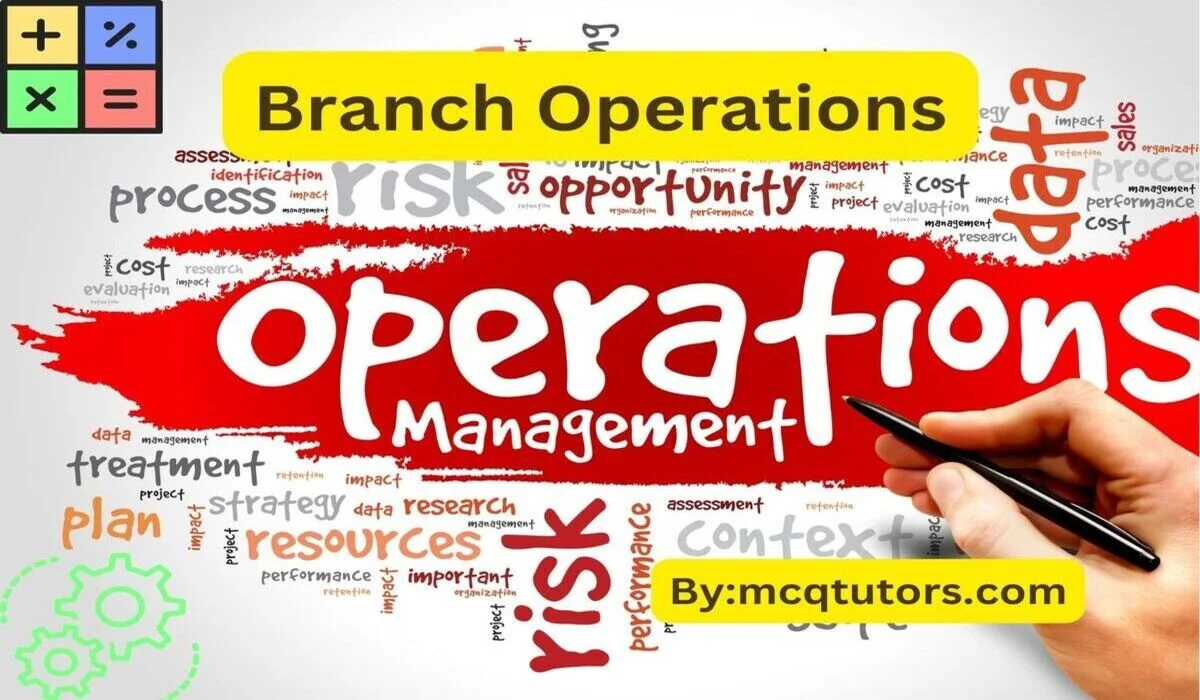Are you preparing for an exam and looking for Branch Operations MCQs? Are you looking for multiple-choice questions (MCQs) with answers in PDF format? Then look no further!
In this article, we will provide a comprehensive list of the most important Branch Operations MCQs with their corresponding answers in a convenient PDF format.
These questions cover the basic fundamentals of Branch Operations and are designed to help you understand the concepts better and prepare effectively.

Branch Operations MCQs with Answer
1. ___ defines international banking as a sub set of commercial banking transactions
a. Aliber
b. Phillip callier
c. Kotler
d. Taylor
Ans. A
2. Public sector banks include:-
a. Nationalized banks
b. SBI and its subsidiaries
c. Regional Rural Banks
d. All of the above
Ans. D
3. ___ refers to the cross-currency facts of banking businesses
a. Cross-border banking
b. International banking
c. Overseas banking
d. None of the above
Ans. B
4. Under section 49A of the banking regulation act “No person other than bank is authorized to accept deposit withdrawal by cheque”. Exemptions to above case are: –
a. Savings Bank scheme by government
b. Any firm or person notified by government
c. Central government authority
d. Both a & b
Ans. D
5. Traditionally banks met their liquidity needs by
a. Manipulating their asset structure
b. Their liquid assets
c. Rely solely on asset management
d. None of the above
Ans. A
6. ___ in terms of twice & cost in central to asset and liability management
a. Asset liquidity
b. How “salable” the bank’s
c. Both a & b
d. None of the above
Ans. C
7. In country like India, Majority of rural population was governed by
a. Unorganized group of Bankers
b. Indigenous Banks
c. Money lenders
d. All of the above
Ans. D
8. Central Bank of a country:-
a. Occupies a central position in the monetary & banking structure of the country
b. Acts as the leader of money market
c. Sole right of note issue
d. All of the above
Ans. D
9. The central Bank of India is
a. RBI
b. SBI
c. ICICI
d. IDBI
Ans. A
10. Liquid assets normally maintained as
a. Liquidity buffer
b. Salable bank’s assets
c. Yield generators
d. Can’t say
Ans. A
11. The central Bank functions under –
a. General superintendence
b. Central Board of directors
c. Central regulatory authority
d. Both a & b
Ans. D
12. Developmental banks play the role of
a. Development corporation
b. Finance corporation
c. Both a & b
d. Only b
Ans. C
13. Identify the liability sources-
a. Money markets
b. Liquidity
c. Deposits
d. Government funds
Ans. A
14. ___ structure is a key aspect of liquidity management
a. Product
b. Funding
c. Deposits
d. None of the above
Ans. B
15. A bank with a ___ deposit base have fever liquidity problems
a. Stable
b. Large
c. Diverse
d. All of the above
Ans. D
16. Famous Indian bank transacts foreign exchange business
a. SBI
b. RBI
c. HDFC
d. IDBI
Ans. A
17. Central Board of directors comprises
a. Governor
b. Four deputy governor
c. Directors nominated by central government
d. All of the above
Ans. D
18. ___ is used to refer to the ownership of banks facilities located in one country by citizens of another
a. International banking
b. Foreign banking
c. Eurocurrency banking
d. All of the above
Ans. B
19. The term ___ refers to the location and ownership of banking facilities in a large number of countries and geographic regions.
a. Multinational banking
b. Eurocurrency banking
c. International banking
d. Foreign banking
Ans. A
20. IBFs are directly equivalent to the operations of US banks with
a. Booking
b. Shell
c. Brass plate center
d. All of the above
Ans. D
21. ___ of a bank directly impacts cost of operation.
a. Organizational structure
b. Funding structure
c. Budget structure
d. Both a & b
Ans. B
22. Funding structure determines a bank’s
a. Profit potential risk level
b. Assets, liabilities
c. Deposits loans
d. Both a & b
Ans. A
23. Inter-bank funding includes all
a. Deposits
b. Loans
c. Advances
d. All of the above
Ans. D
24. ___ normally exposes a bank to additional currency risk.
a. Inter bank finding
b. Foreign funding
c. International borrowing
d. None
Ans. C
25. The existence of ___ is a good indicator of international confidence. In a country and its economy.
a. Vostro accounts
b. Foreign funding
c. Export promotion agencies
d. Endorsement
Ans. B
26. The money market is a market for ___ that are close substitutes of money
a. Short term financial assets
b. Long term financial assets
c. Both a & b
d. Sudden demand
Ans. A
27. the most important feature of a money market instrument is
a. It is liquid
b. It can be turned over quickly at low cost
c. It provides an avenue for equilibrating the short term surplus finds of lendess and the requirements of brownness
d. All of the above
Ans. D
28. ___ is the ultimate determinant of a bank’s lending capacity
a. Balance
b. Funds
c. Capital
d. Deposits
Ans. C
29. A bank’s balance sheet cannot be a expended beyond the level determined by its ___
a. Capital adequacy ratio
b. Assets liabilities ratio
c. Buffer stock
d. Amount of capital impacts
Ans. A
30. In ___ the based committee started consultations leading to issuance of new capital accord.
a. 1998
b. 1999
c. 1996
d. 2000
Ans. B
31. The additional pillars of new capital framework are
a. An enhanced supervisory review process
b. Minimum capital requirements
c. Effective use of market discipline
d. Both a & b
Ans. D
32. Based a record comprises
a. Definition of regulatory capital
b. Measures of risk exposures
c. Rules specifying the level of capital maintained in relation to these risks
d. All of the above
Ans. D
33. Basel capital accord of 1988, introduce a ___ based on the risk weighted composition of a bank’s assets and off balance sheet exposures
a. Defector capital adequacy standard
b. Consistent adequacy ratio
c. Safe guard solvency
d. Incomplete information
Ans. A
34. In, the ___ on banking supervisor took the lead the develop convergence of supervisory regulations governing the capital adequacy of internationally active banks
a. 1975, Narasimha committee
b. 1995s, Verma committee
c. 1980s, Basel Committee
d. All of the above
Ans. D
35. Until the 1980 bank act was passed, opening of foreign bank subsidiaries within ___was prohibited
a. Japan
b. Canada
c. Russia
d. Britain
Ans. B
36. A ___ is part of a parent organization that is incorporated else where
a. Consortium banks
b. Bank agencies
c. Foreign branch
d. All of the above
Ans. C
37. ___ banks are joint ventures of the larger commercial banks.
a. Consortium
b. Foreign
c. Local
d. Central
Ans. A
38. Consortium banks are primarily concerned with
a. Investment
b. They arrange large loans
c. Under write stocks & bonds
d. All of the above
Ans. D
39. Central bank financing was directed toward a special purpose determined by
a. Capital
b. Government
c. Government policies
d. Financial innovation
Ans. C
40. The ___ of a bank represents the buffer available to protect creditors against losses
a. Capital
b. Funds
c. Loans
d. Advances
Ans. A
41. Under ___ funds are transacted on overnight basis and under ___, funds are transacted for the period’s b/w 2 days and 14 days
a. Call money market, notice money market
b. Notice money market, call money market
c. Inter-bank market, notice money market
d. None of the above
Ans. A
42. Two essential functions of commercial banks are
a. Borrowing lending
b. Deposits, withdrawal
c. Tending, investments
d. All of the above
Ans. A
43. Formation and management of co-operative societies comes under the control of ___ while licensing and regulation of banking business nests with ___
a. BR act, RBI act
b. State government RBI
c. Central government Cooperative societies
d. Both a & b
Ans. B
44. In Asia in ___ and in Europe in ___ the financial crisis took place
a. 1997, 1998
b. 1996, 1998
c. 1998, 1995
d. 1997, 1992
Ans. A
45. Indian financial system is classified into ___& ___ sector
a. Structured, unstructured
b. Organized, unorganized
c. Primary, Secondary
d. None of the above
Ans. B
46. The scheduled banks grouped into ___ banks and ___ banks.
a. Indian banks, foreign banks
b. Co-operative, Commercial
c. Central banks, Exchange banks
d. None of the above
Ans. A
47. The ___ and ___ of capital impacts a bank’s competitive position
a. Loans, advances
b. Cost amount
c. Safety, soundness
d. All of the above
Ans. B
48. Costs associated with monetary policy regulations are ___ and ___
a. Minimum reserve requirements, capital adequacy requirements
b. Credit substitutes, Capital adequacy
c. Both a & b
d. None of the above
Ans. A
49. In order to grant ___ and ___ a bank should be able to attract deposits from public
a. Loans, advances
b. Cost, amount
c. Advances, capital
d. None of the above
Ans. A
50. Industrial banks plays an important role in the ___and ___of the companies
a. Designing & implementation of policies
b. Management & administration
c. Shares and debentures
d. None of the above
Ans. B
Conclusion
This article has provided an overview of the common MCQs related to branch operations. It is important for those in the banking industry to understand these questions and their answers in order to be successful in their role.
Furthermore, having a solid understanding of financial products and services along with the ability to adhere to compliance standards are also vital aspects of effective branch operations.
Read More MCQs



